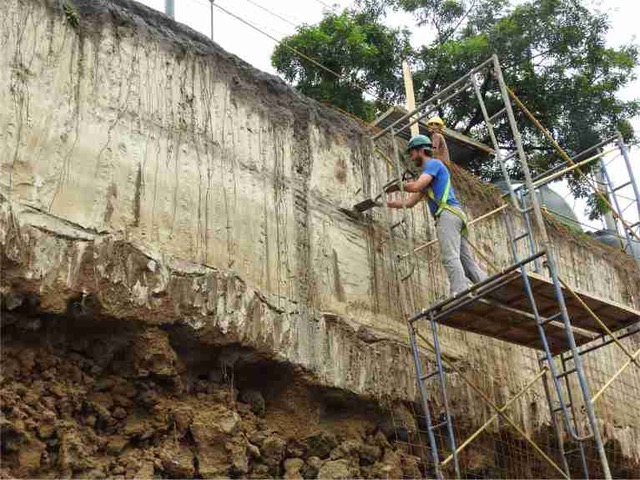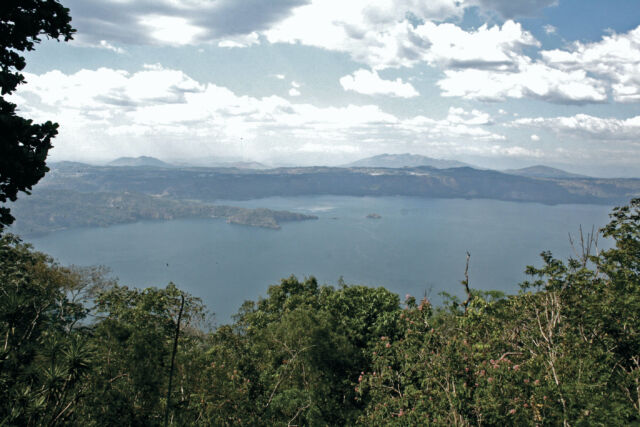The Maya vs. the Volcano —
A recent study suggests the 431 CE eruption affected only a small region.
Kiona N. Smith
–

Gerardo Aguirre-Díaz
Maya civilization was blossoming into its golden age when a volcano erupted at the southern edge of the Maya region, in what is now El Salvador. Tens of meters of ash and debris buried the densely populated, fertile farming valleys around the Ilopango caldera. Aerosols blasted into the stratosphere by the eruption settled as far away as Greenland and Antarctica. While the wider Maya civilization was mostly unaffected, it took a century and a half for life to resume in the shadow of Ilopango.
In a recent study, Oxford University archaeologist Victoria Smith and her colleagues used tree rings from a stump caught in a pyroclastic flow, along with data from polar ice cores obtained more than 7,000km (4,300 miles) away. These dated the eruption to 431 CE, the early part of the Maya Classic Period. The date may help future archaeologists and climate researchers better understand the impacts of the eruption on Central America and the rest of the world.
Buried by Tierra Blanca Joven
Volcanoes make dangerous neighbors, but they have ways of drawing people close despite the risks. Fertile volcanic soils in the valleys of El Salvador supported dense populations in Maya villages and urban centers like Chalchuapa. By the beginning of the Maya Classic Period, around 250 BCE, the rulers at Chalchuapa had built temples and a ball court at the site. Artifacts found among the ruins reveal trade connections as far away as central Mexico.
The Classic Period is sometimes known as the golden age of Maya civilization, when the culture’s influence and power expanded, its cities grew larger and wealthier, and its architecture and art flourished. But then Ilopango, the volcano slumbering 10km (6 miles) east of the Chalchuapa, roared to life.
When archaeologists began excavating the buried remains of Chalchuapa (which sits alongside a modern city of the same name), they found that the materials from the early Classic Period lay beneath a thick layer of white volcanic ash and pumice. The same layer of ash appears all over the region in pale outcrops, so geologists named the eruption “Tierra Blanca Joven” for the “young white earth” it left behind.
Those deposits also told the story of the eruption. Smith and her colleagues measured the depth of the layers at 72 locations in the area around Ilopango. They used that data to create a 3D model of the ash and rock that Ilopango had thrown out and to simulate some aspects of the eruption.
The Tierra Blanca Joven eruption blasted a plume of ash and dust 45km (28 miles) into the sky. Winds spread the ash over a broad swath of Central America and out over the Pacific Ocean. A dusting of ash even fell across the Maya lowlands, hundreds of kilometers to the north. Some of that ash, along with aerosolized particles of sulfur and other chemicals, made it into the upper layers of Earth’s atmosphere, where currents carried them nearly 7,800km to the ice caps of Greenland and Antarctica.

Enlarge / This scenic lake is the caldera of Ilopango, which last erupted in the 1800s.
Gerardo Aguirre-Díaz
Closer to the volcano, the towering plume collapsed under its own weight, sending swift, deadly currents of hot gas, ash, and pumice—pyroclastic flows—racing across the ground for 50km or more. A layer of ash and pumice up to 70m (230 feet) deep choked some of the valleys nearest the volcano, and a layer 2m (6 feet) deep blanketed hundreds of square kilometers of Maya farmland.
With no written accounts and only limited archaeological evidence, we don’t know how many people died, how many homes were leveled, or how much warning people had.
But there’s no question that the eruption was devastating. At around the same time as the Tierra Blanca Joven eruption, ceramics made in El Salvador stop showing up in the archaeological record at Maya sites. “We think the lack of ceramic production in the general area is because people were not there,” Smith told Ars, “as much of it was uninhabitable for many years, and it would have taken decades for the landscape to recover.”
Wiggle-matching and dating a disaster
A few hundred kilometers away, in the lowlands of Guatemala and Belize, people must have noticed the centimeter or so of ash that coated their homes, temples, streets, and fields, but the Maya heartland was spared Tierra Blanca Joven’s worst impacts. The Maya expansion of the Classic Period carried on despite the devastation around Ilopango. However, we don’t yet have enough evidence to say how the local disaster affected the wider trade networks of which Chalchuapa was a part or how all those aerosols in the stratosphere affected the world’s climate in the years after the eruption.
If you want to really understand the wider impacts of a volcanic eruption, you need to know when it happened in order to say what happened afterward. But dating Tierra Blanca Joven hasn’t been easy. Radiocarbon dates on bits of wooden debris found in the pyroclastic layers could only narrow it down to somewhere between 270 and 562 CE. That spans nearly the entire Maya Classic Period.
Smith and her colleagues found a mahogany tree stump (“slightly charred,” they note) mixed in with the rubble of a pyroclastic flow from the eruption. They radiocarbon-dated several of its rings, then matched the year-by-year record of the tree’s age to the radiocarbon calibration curve generated from samples of known ages.
(This is done using a process called wiggle-matching. And then someone had to type the phrase “wiggle-matching” into a serious academic paper and submit it to the Proceedings of the National Academy of Science.)
Wiggle-matching the tree stump narrowed the date of the eruption down to 425-440 CE. That was a small-enough range to justify a close look at layers of ice in core samples from Greenland and Antarctica, where Smith and her colleagues hoped to find signs of volcanic ash or a sudden increase in sulfur falling from the sky.
In a layer of Greenland ice dating to 431 CE, they found the ash; the chemical makeup of its tiny glass shards lined up well with the material spewed forth from Ilopango. The sulfur blasted into the stratosphere during the eruption took longer to settle back to Earth; Smith and her colleagues found that in ice layers dating to 433 CE in samples from both Greenland and Antarctica. Those dates lined up well with the archaeological evidence.
Aftermath unclear
Smith and her colleagues estimate that Tierra Blanca Joven shot more sulfur into the atmosphere than the 1991 eruption of Mount Pinatubo in the Philippines, which cooled subtropical summers by about 1⁰C for the next couple of years. Sulfur compounds in the upper atmosphere reflect sunlight and keep parts of the atmosphere cooler during the summer; the effect lasts until the particles finally fall back to earth, which can take up to a decade.
But despite the impressive volume of sulfur that Tierra Blanca Joven pumped into the upper atmosphere, there’s no evidence that it had a global—or even regional—impact on the climate.
Smith and her colleagues say that based on their modeling, the eruption probably lowered summer temperatures by about 0.5⁰C to 1⁰C in the Southern Hemisphere “for a few years.” Normally, volcanoes in the tropics have a larger impact on the Northern Hemisphere thanks to prevailing atmospheric currents, but the volcano seems to have deposited higher concentrations of sulfur compounds in Antarctica than in Greenland. That suggests that it cast its cooling shadow over the Southern Hemisphere.
“Unfortunately, there are too few well-dated paleoclimate proxy records for the Southern Hemisphere to verify the climatic effects of the eruption,” Smith and her colleagues wrote. Now that the eruption has been dated, they say that finding and analyzing ancient climate records from sources like lake and ocean sediments, ice cores, tree rings, and cave formations could help understand how (or whether) Tierra Blanca Joven impacted the climate in its aftermath.
Modeling ancient volcanic eruptions can help explain what happened in the past and also inform disaster preparedness today. That’s not a terrible idea, since Ilopango is still one of about 20 potentially active volcanoes in El Salvador alone. It’s been pretty quiet since the 1800s, but we can’t count on that continuing.
Life, uh, finds a way
Meanwhile, people have resettled the lands around Ilopango, and the modern Chalchuapa is a vibrant community. It sits alongside a cluster of pre-Colombian Maya sites, including the architectural complex of Tazumal, where Maya elites built their pyramids, ball court, and other ceremonial structures just before Ilopango buried the city and its surrounding farmlands.
A century or so after the Tierra Blanca Joven eruption, ceramics from El Salvador were back on the market around the Maya world, and excavations at Tazumal suggest that the complex was back in use by the end of the Classic Period around 600 CE. It lasted another few centuries until people moved elsewhere in 1200 CE.
In other words, people in ancient El Salvador kept going even in the wake of disaster. Eventually, they reoccupied and rebuilt a ruined city, replanted farms, and expanded a civilization. And even after the more widespread devastation of European colonialism, Maya people and their culture continue to live and thrive today. Humans are resilient that way.
And that may be the single most important thing we can ever learn from the past.
PNAS, 2020 DOI: 10.1073/pnas.2003008117 (About DOIs).

